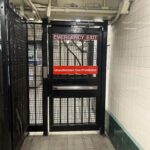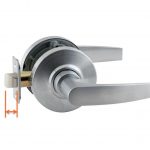I’m a big believer in finding a good solution / best practice and applying it consistently. Of course, if a better idea comes along, I adjust my process if it makes sense to do so. But I’m not the type of person who just randomly jumps from one plan to the next…maybe that’s why I like codes so much.
I feel the same way about school security – let’s find the best way to handle the various types of openings and apply those practices consistently. There will always be some variation based on existing conditions, door types, facility preferences, etc. but consistently applying best practices translates to greater security and safety.
I think this is one of the reasons I’m having such a hard time with random state legislation which ignores the established life safety codes and recommendations so that a wide variety of gadgets can be used to lock classroom doors. I feel like a broken record, but there are so many potential problems when doors are secured without considering egress/evacuation, fire protection, accessibility, and unauthorized lockdown (you can read about those concerns here).
Over the weekend I saw a news report (embedded below) from WHEC News 10 in New York. The story is about a proposed change to NY law, which would allow schools to use “doorstops” (classroom barricade devices and other methods of keeping a door closed). You can read the complete bill here, but here’s the main text that will be considered in the next legislative session:
“Optional emergency doorstops. Notwithstanding any law, rule or regulation to the contrary, all school districts may utilize doorstops or any improvised or manufactured devices designed to prevent a door from being opened during an emergency in classrooms during emergency situations to prevent access to such classrooms. For purposes of this section, emergency situation shall not include any situation involving a fire hazard.”
The New York State Manual of Planning for School Buildings currently requires: “Hardware on doors from spaces of pupil occupancy shall be a type which will always permit the door to be opened from the inside without direct manipulation of any type locking device.” (Section S105-1)
Why would state legislators consider removing a requirement that ensures free egress and the option of evacuating, and replacing it with language that allows just about anything (“ANY improvised or manufactured devices”)? How is a teacher supposed to know if the current emergency involves a fire hazard? Why does each state need its own rules for classroom security? Wouldn’t it be better to continue to have a consistent approach used nationwide?
Here’s the news report:
You need to login or register to bookmark/favorite this content.





I apologize in advance, as i’m sure this opinion will elicit negative responses, but why not solve the underlying problem rather than deal with all of the ill-advised, amateurish attempts at a band-aid solution?
When do we stand up and let corporations know that they in fact do not own us and that the government’s first responsibility is to protect its citizens, not corporate profits?
It is unfortunate that we continue to see these knee-jerk reactions to the problem rather than cool heads thinking through the issue and coming up with solutions that both satisfy existing codes as well as address the new concerns.
It is also unfortunate that in many cases a lack of good parenting has led to these issues. Guns were around (and much more easily available) when I was a kid and we did not have shootings in schools. Looking into the root of the issue is as important (or more) than putting a band-aid on the problem by creating high security day prisons (schools) for our kids.
If a button on the inside of an entry function lever handle lockset wont stop an attacker from perhaps a kick or shooting the lock open then why not a door stop?
If it can be removed just as fast as pushing a push bar or grabbing door handle and my kids or yours in that classroom then Im all for it for “Safety”.
Hi Anthony –
In past school shootings, assailants have not typically shot the locks off. In some cases, the glass next to the hardware was broken in order to reach through and unlock the door, which is why the glazing must be addressed. In the 3 states where state legislation has been passed in order to allow classroom barricade devices, the language is very vague. There is no guarantee that the device or method used in a classroom will be “just as fast” as operating traditional hardware.
– Lori
I feel like this issue needs a national spokesperson or something. Maybe the “Lock It Don’t Block It” campaign needs more exposure like the “Click-it or Ticket” seat belt campaign or Smokey the Bear. The general public just simply does not understand that door locks can secure your door and are likely already installed. It’s usually just a policy and procedures change in the school. People are scared. My husband is a teacher and the SRO in his school shared the video with the chair you posted last week. My husband immediately texted him and told him why this was a bad idea (I guess my husband does listen to me sometimes!). The SRO pulled the video down. I’ve talked to school administrators, government officials, other industry professionals, first responders, parents etc about school security and it is usually takes a few times of me explaining how simple locking the doors is for them to get it and then they’re completely on board. I know there are other layers here but lets start simple and with tools we already have instead of using these makeshift devices. To feel safe people need to feel in control. Proper training and school policy change can help with that. I also agree with the previous comment for what its worth…
I agree Kim! It’s tough because the bad ideas and misinformation travel quickly by social media and even the traditional media. It’s hard to get anyone to stop for a minute and think about all angles of the issue.
– Lori